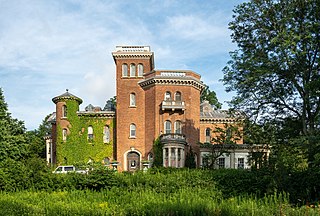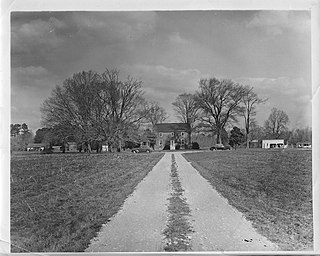
Monticello was the primary plantation of Thomas Jefferson, the third president of the United States, who began designing Monticello after inheriting land from his father at age 26. Located just outside Charlottesville, Virginia, in the Piedmont region, the plantation was originally 5,000 acres (20 km2), with Jefferson using the labor of enslaved African people for extensive cultivation of tobacco and mixed crops, later shifting from tobacco cultivation to wheat in response to changing markets. Due to its architectural and historic significance, the property has been designated a National Historic Landmark. In 1987, Monticello and the nearby University of Virginia, also designed by Jefferson, were together designated a UNESCO World Heritage Site. The current nickel, a United States coin, features a depiction of Monticello on its reverse side.

Marion is a town in and the county seat of Smyth County, Virginia, United States. Conveniently positioned upon Interstate 81, Marion is easily accessible. Located in the Blue Ridge portion of the Southern Appalachian mountains in Southwest Virginia, the general Marion area is well known for its scenic beauty. The town is named for American Revolutionary War officer Francis Marion. The town limits had a population of approximately 6,000, per 2020 Census estimates. However, together with the neighborhoods, an additional 9,000 residents in unincorporated Smyth County have Marion mailing addresses, giving the Marion, VA ZIP code (24354) a population of over 15,000, which is about half of the county's total population.

Poplar Forest is a plantation and plantation house in Forest, Bedford County, Virginia. Thomas Jefferson designed the plantation and used the property as a private retreat and a revenue-generating plantation. Jefferson inherited the property in 1773 and began designing and working on the plantation in 1806. While Jefferson is the most famous individual associated with the property, it had several owners before being purchased for restoration, preservation, and exhibition in 1984.

James Madison's Montpelier, located in Orange County, Virginia, was the plantation house of the Madison family, including fourth president of the United States, James Madison, and his wife Dolley. The 2,650-acre (10.7 km2) property is open seven days a week with the mission of engaging the public with the enduring legacy of Madison's most powerful idea: government by the people.

Swannanoa is an Italian Renaissance Revival villa built in 1912 by millionaire and philanthropist James H. Dooley (1841–1922) above Rockfish Gap on the border of northern Nelson County and Augusta County, Virginia, in the US. It is partially based on buildings in the Villa Medici, Rome.

The Octagon House, also known as the Colonel John Tayloe III House, is located at 1799 New York Avenue, Northwest in the Foggy Bottom neighborhood of Washington, D.C. After the British destroyed the White House during the War of 1812, the house served as the temporary residence of James Madison, President of the United States, for a period of six months. It is one of only five houses to serve as the Presidential residence in the history of the United States of America and one of only two (along with the White House and Blair House that still stand.

Mount Airy, near Warsaw in Richmond County, Virginia, constructed in 1764 for Colonel John Tayloe II, perhaps the richest Virginia planter of his generation, is a mid-Georgian plantation house, the first built in the manner of a neo-Palladian villa. John Ariss is the attributed architect and builder. Tayloe's daughter, Rebecca and her husband Francis Lightfoot Lee, one of the only pair of brothers to sign the Declaration of Independence are buried on the estate, as are many other Tayloes. Before the American Civil War, Mount Airy was a prominent racing horse stud farm, as well as the headquarters of about 10-12 separate but interdependent forced-labor plantations along the Rappahannock River. Mount Airy is listed on the National Register of Historic Places as a National Historic Landmark as well as on the Virginia Landmarks Register and is still privately owned by Tayloe's descendants.

Kenmore, also known as Kenmore Plantation, is a plantation house at 1201 Washington Avenue in Fredericksburg, Virginia. Built in the 1770s, it was the home of Fielding and Betty Washington Lewis and is the only surviving structure from the 1,300-acre (530 ha) Kenmore plantation.

Barboursville is the ruin of the mansion of James Barbour, located in Barboursville, Virginia. He was the former U.S. Senator, U.S. Secretary of War, and Virginia Governor. It is now within the property of Barboursville Vineyards. The house was designed by Thomas Jefferson, president of the United States and Barbour's friend and political ally. The ruin is listed on the National Register of Historic Places.

Menokin, also known as Francis Lightfoot Lee House, was the plantation of Francis Lightfoot Lee near Warsaw, Virginia, built for him by his wife's father, John Tayloe II, of nearby Mount Airy. Lee was a signer of the United States Declaration of Independence. Menokin was declared a National Historic Landmark in 1971.

Shack Mountain is a house near Charlottesville, Virginia, that is a tribute to Thomas Jefferson's architectural style. It was designed by and for Fiske Kimball (1881-1955), an architectural historian who was the founder of the University of Virginia School of Architecture, and who is credited with restoring respect for Jefferson's architectural ability. The house derives its name from the Shackelford family, who owned and settled the property in the 18th century.

Litchfield Villa, or "Grace Hill", is an Italianate mansion built in 1854–1857 on a large private estate now located in Prospect Park, Brooklyn, New York City. It is located on Prospect Park West at 5th Street. The villa was designed by Alexander Jackson Davis, America's leading architect of the fashionable Italianate style, for railroad and real estate developer Edwin Clark Litchfield.

Riversdale, is a five-part, large-scale late Georgian mansion with superior Federal interior, built between 1801 and 1807. Also known as Baltimore House, Calvert Mansion or Riversdale Mansion, it is located at 4811 Riverdale Road in Riverdale Park, Maryland, and is open to the public as a museum.

Historic Blenheim is a c. 1859 brick farm house designed in the Greek Revival style and located in City of Fairfax, Virginia. During the American Civil War, Union soldiers were often encamped on the grounds surrounding the house and utilized it as part of a reserve hospital system. As a result, more than 115 of these soldiers inscribed words and pictures on the first and second floor walls, as well as the attic of the house. Blenheim was added to the National Register of Historic Places in 2001.

Pear Valley is a one-room yeoman's cottage and prime example of vernacular architecture in Eastville, Virginia. The modest embellishments and its high level of preservation make it one of the most architecturally interesting examples of small, historic homes in Virginia.

Green Springs was built in the late 18th century on lands in Louisa County, Virginia assembled by Sylvanus Morris. His son Richard (c.1740-1821) developed 1,746 acres (707 ha) near the mineral springs that gave the property its name and built the two-story frame house. The property stands in an unusually fertile region of central Virginia, surrounded by a number of 18th and 19th century farms and plantations. The district has been designated a National Historic Landmark district, comprising about 14,000 acres (5,700 ha) under scenic easement protection.

Farmington is a house near Charlottesville, in Albemarle County, Virginia, that was greatly expanded by a design by Thomas Jefferson that Jefferson executed while he was President of the United States. The original house was built in the mid-18th century for Francis Jerdone on a 1,753-acre (709 ha) property. Jerdone sold the land and house to George Divers, a friend of Jefferson, in 1785. In 1802, Divers asked Jefferson to design an expansion of the house. The house, since greatly enlarged, is now a clubhouse.

Upper Wolfsnare, historically called Brick House Farm until 1939, is a colonial-era brick home built, probably about 1759, in Georgian style by Thomas Walke III in Virginia Beach, Virginia.

Lincoln Theatre is a historic theatre building located at Marion, Smyth County, Virginia. It was opened in 1929, and is a three-story theater located behind the Royal Oak Apartment House. Access to the theatre is through a broad arcade on the ground floor of the apartment house. The interior of the theatre is designed to suggest an ancient Mayan temple. It also features six large paintings, depicting scenes from American and local history. The theatre closed in 1977. It later reopened in 2004 as a community performing arts center.
























